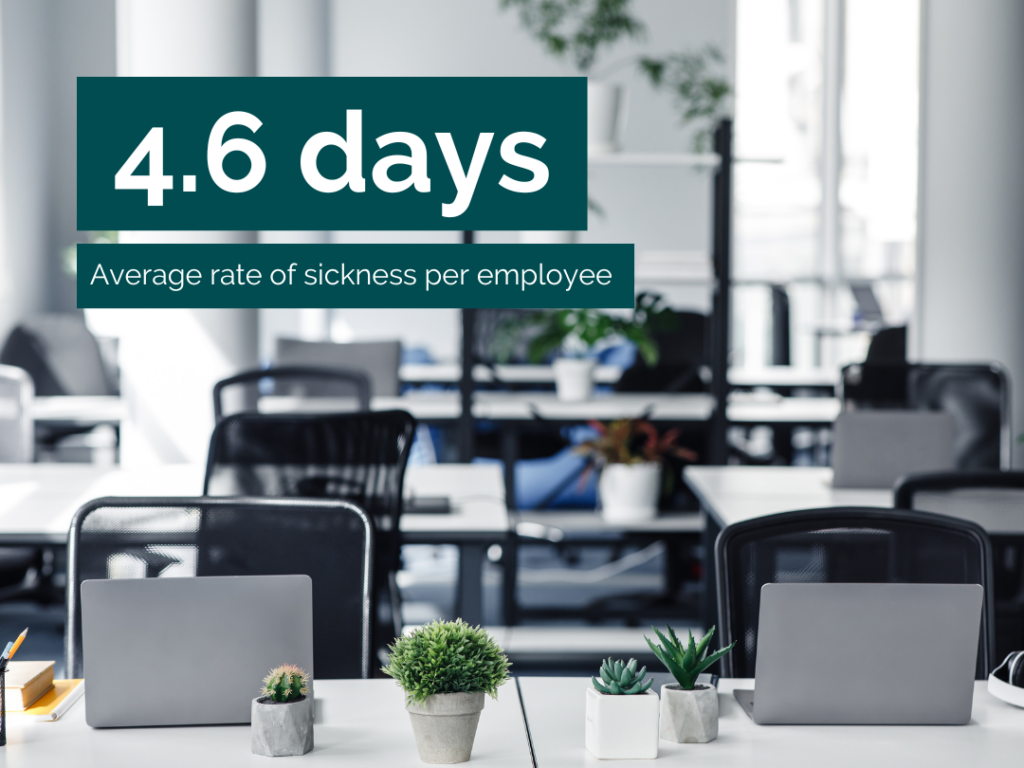5 common questions about workplace absence
Sickness absence costs UK businesses billions of pounds yearly, with mental health issues being one of the most significant contributors to ill health. There is a bigger cost in terms of the impact on individual employees.
Greater work-related stress also increases the risk of tribunals and workplace conflicts.
Much of this is avoidable if we can broker a healthier conversation between employer and employee.
Our FAQs below explore the causes of some of the most common reasons for ill health among UK workers and the statistics you need to know. See our factsheet for practical tips on ensuring your staff maintain good mental and physical health.

What is the rate of sickness absence?
The UK workforce had a sickness absence rate of 2.1 %, according to data gathered by the Office of National Statistics covering employee sick days during 2021. Numbers were up from a low of 1.8% in 2020. In 2021, 149.3 million working days were lost to sickness.
The figures equate to an average of 4.6 days per employee.
The UK has some of the lowest rates of absence in Europe. However, the figures are misleading.
It’s thought presenteeism, the pressure to be at work while unwell, is higher among UK employees, contributing to poor mental health – the most significant cause of ill-health among employees.

Presenteeism is higher among UK employees.
1. What are the commonest causes of workplace absence?
The latest statistics from the Office of National Statistics (ONS, 2021) reveal that the commonest causes of workplace absence were:
- Minor illnesses (21.9%): includes colds, viruses and other bugs.
- Musculoskeletal problems (13.4%): covers any conditions affecting bones, muscles and joints.
- Mental health conditions: 8% – stress, depression, anxiety and other mental health issues.
- Other (21%): Includes covid absences and some illnesses such as diabetes.
COVID-19 accounted for nearly one in four of all occurrences of sickness absence in 2021, according to the ONS.
Find out how to reduce workplace absence in our free factsheet.
2. How common are mental health conditions in the workplace?
Working conditions considerably impact mental health, and, equally, someone’s mental health can significantly affect performing well in their job.
Statistics show that almost 15% of people (14.7%) of people experience mental health problems in the workplace.
Evidence suggests that 12.7% of all sickness absence days in the UK can be attributed to mental health conditions. Another report says nearly half of all long-term absence/sick leave in the UK is attributed to mental health issues.

- See five stats about workplace health and how to combat it.
- Read our tips for supporting mental health in the workplace.
3. What is the cost of sickness absence to employers?
Estimates of the cost of business absence vary by source. For example, a poll by Xpert HR found that sickness rates peaked in 2021 at 3.1 per cent, which it claims costs employers on average of £781 for each staff member.
Elsewhere, a 2017 report estimated that UK businesses lose £33-42 billion per year due to mental health issues alone.
One report estimates losses of £33-42 billion per year due to mental health issues.
4. Is sickness higher among specific groups?
The ONS found that groups with the highest rates of sickness absence in 2021 included:
- women,
- older workers,
- people with long-term health conditions,
- people working part-time, and
- people working in caring, leisure and other service occupations.
Women in full-time employment are nearly twice as likely to have a common mental health problem as full-time employed men (19.8% vs 10.9%). In 2021, sickness absence rates for public and private sector workers were 3.0% and 1.9%, respectively.
Find out how to reduce workplace absence in our free factsheet.
Sickness absence rates for public sector workers have been consistently higher than those for private sector workers yearly.
The likelihood of a Long Term Sickness Absence (LTSA) increases with age.
People aged 55-64 were over three times as likely (7%) to have at least one spell of LTSA compared to those under 25 (2%) every year.
People who identify as ‘White’ or of a ‘Mixed’ ethnic group were most likely to have at least one spell of LTSA every year compared to other ethnic groups. Disabled people are five times more likely to have a spell of LTSA than non-disabled people.
5. Does sickness absence vary by occupation?
Yes. There is a difference in sickness absence across sectors and occupations. Those in the caring, leisure and other service occupations experience the highest sickness absence rate out of all industries, followed by process plant and machinery.
As did skilled trade workers, associate professionals, and technology workers saw a low rate. Those in part-time roles saw a high sickness absence rate of 3.1 per cent, compared to just 2 per cent among full-time workers.
And workers in the public sector saw a high rate of 3 per cent, while those in the private sector saw a lower sickness absence rate of 1.9 per cent.
More information from ClearTalents
Interested in our inclusion passport? Discover how to try before you buy
Read our blogs at www.cleartalents.info/blog. Topics include:
- How to do inclusive onboarding
- 5 stats about workplace stress and how you can tackle them
- Tips for supporting mental health in the workplace
Contact us for more information about how we can support you and your staff.